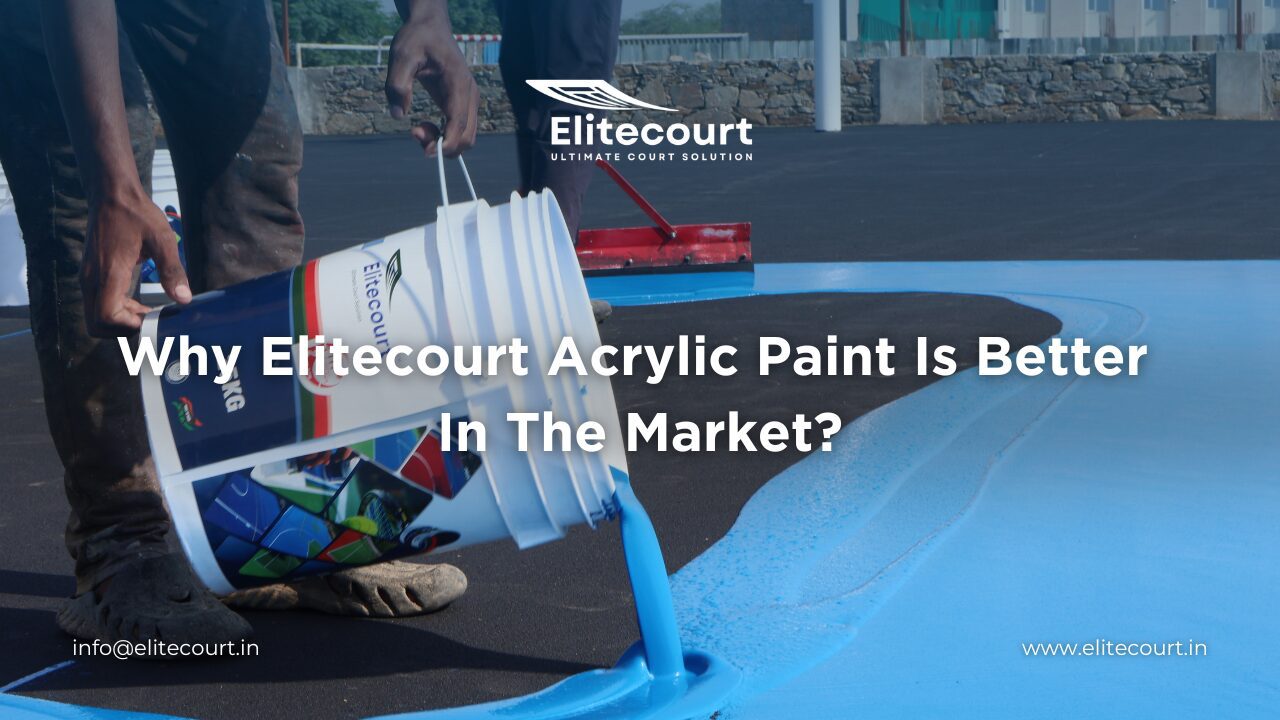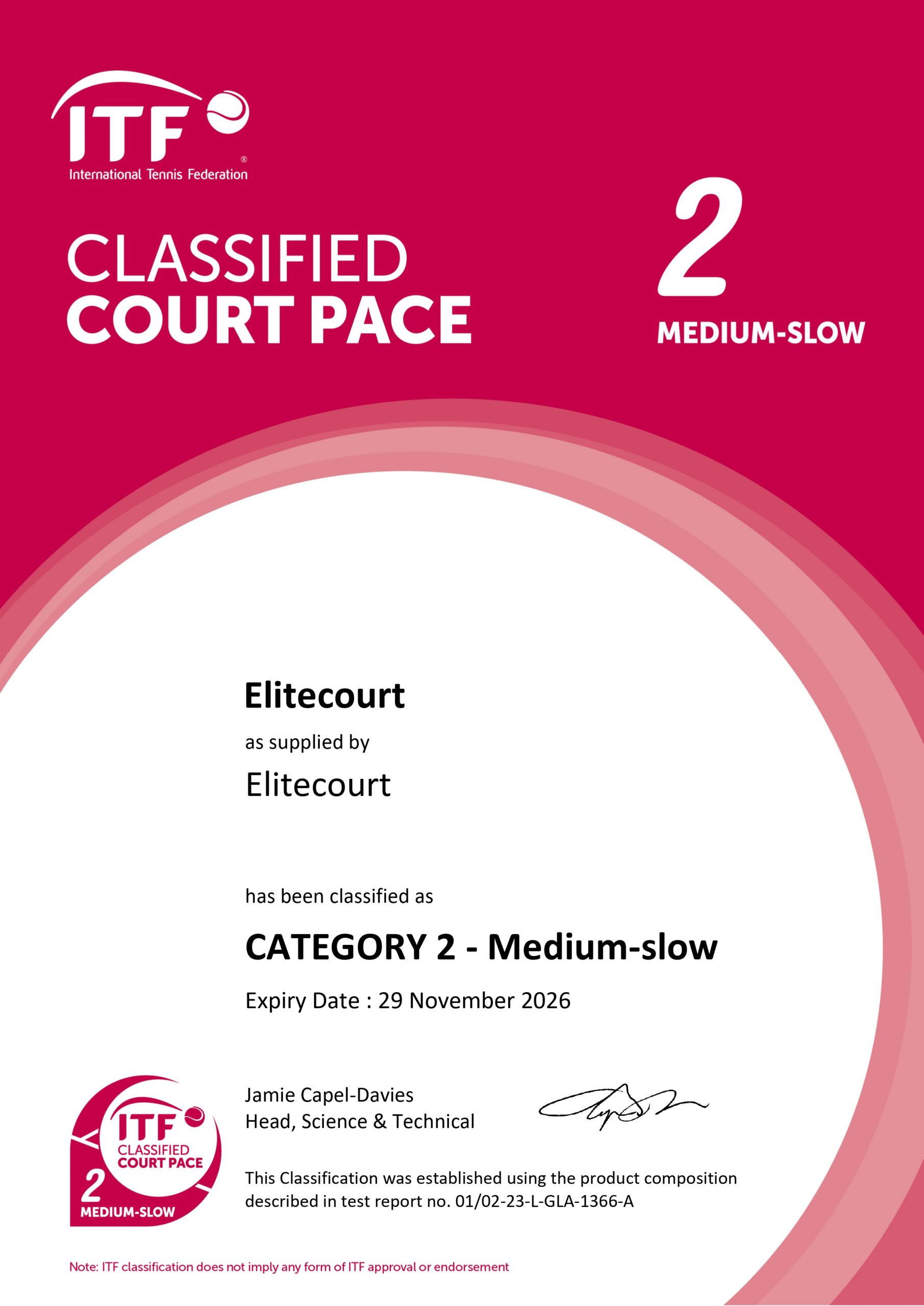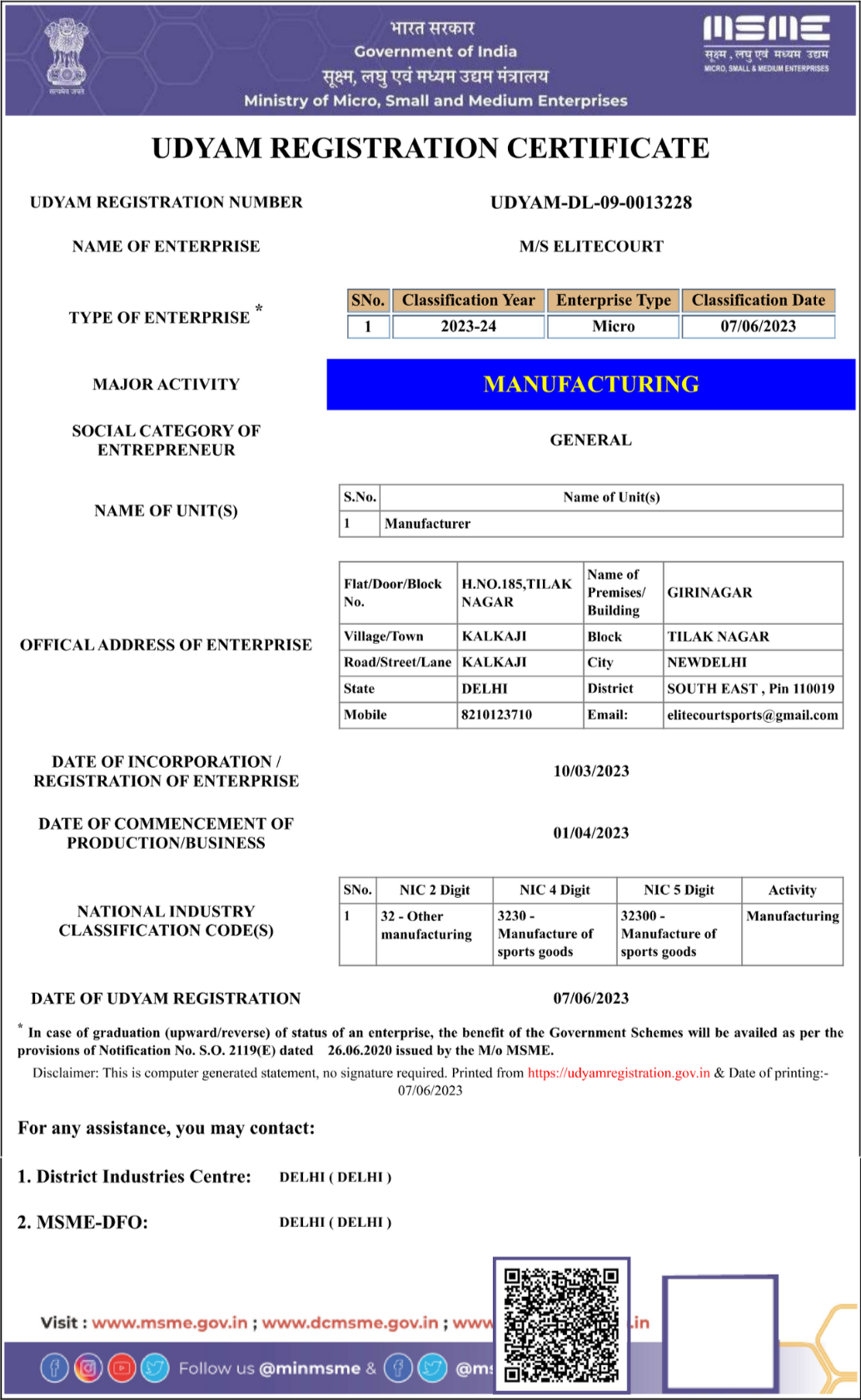How Do You Play Pickleball on a Tennis Court?
With years of experience manufacturing high-quality synthetic acrylic sports flooring, Elitecourt delivers reliable, high-performance solutions for both tennis and pickleball courts. Our materials are trusted across major sports facilities and known for durability, consistency, and professional play standards.
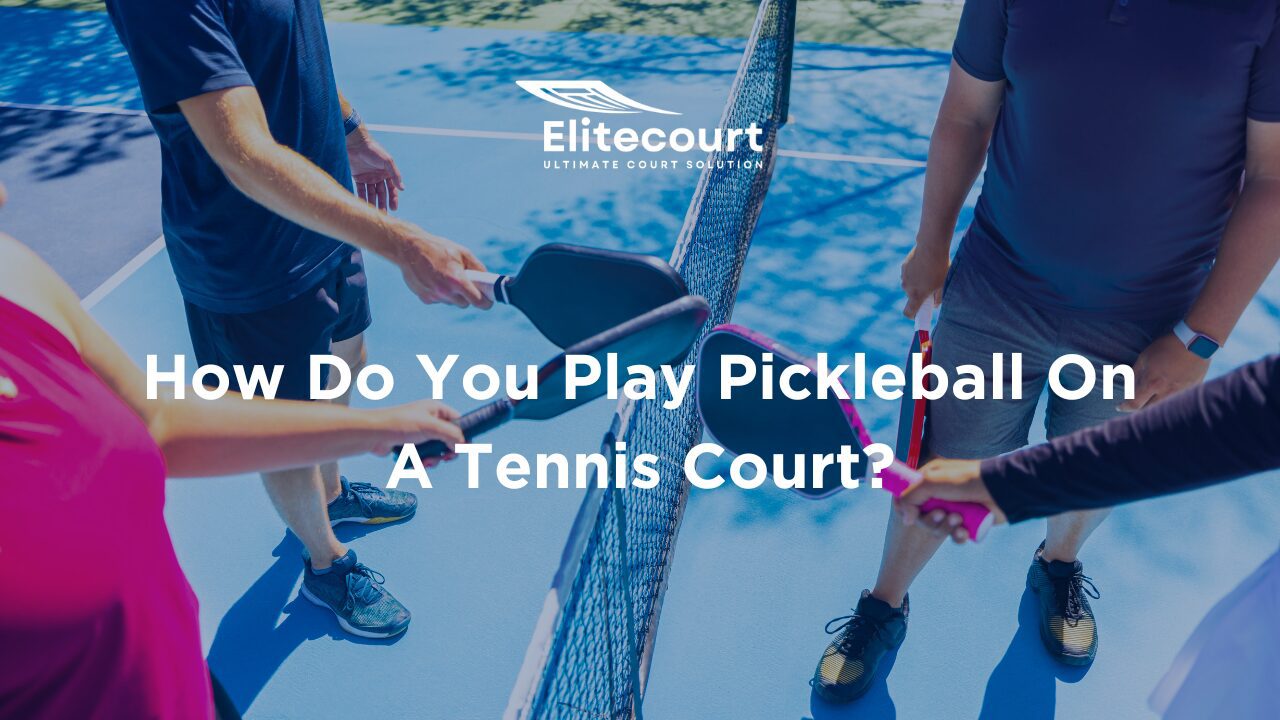
Table of Contents
Introduction: How Do You Play Pickleball on a Tennis Court?
Yes — you can play pickleball on a tennis court, and it is not only possible but increasingly common across sports clubs, schools, community parks, and private facilities. Tennis courts offer more than enough space, the surface is ideal for pickleball when coated with the right acrylic system, and marking layouts can be seamlessly integrated without affecting tennis play. In fact, many facilities transform their existing tennis spaces to support both sports because pickleball continues to be one of the fastest-growing racquet sports worldwide.
But while the general answer is a clear yes, the technical details matter:
How many pickleball courts fit?
What markings are required?
Does the surface need modifications?
How do you maintain performance for both games?
This complete Elitecourt guide breaks down all of these questions, helping you understand exactly how pickleball adapts to tennis courts from a flooring, layout, and playability perspective — backed by professional sports-surfacing expertise.
How Does Pickleball Fit on a Tennis Court?
Pickleball adapts surprisingly well to tennis courts because the foundational requirements—flatness, acrylic surfacing, proper ball bounce, and controlled traction—are the same. Tennis courts have significantly larger dimensions, which makes it easy to overlay or add smaller pickleball courts without altering the base structure. This gives facility managers flexibility to transform their courts into multi-sport zones without rebuilding anything.
Why Tennis Courts Work for Pickleball
Tennis court infrastructure naturally supports pickleball because:
- They already feature high-quality acrylic coatings, ideal for bounce and grip.
- The surface slopes are designed for proper drainage and ball response.
- The boundaries are large enough to comfortably fit multiple pickleball layouts.
- Surrounding fencing prevents ball loss and supports safe play.
- Multi-sport usage does not interfere with the structural integrity of the court.
Pickleball requires a smaller footprint — only 20 ft × 44 ft — compared to a tennis court’s much larger 36 ft × 78 ft singles play area. This dimensional compatibility makes tennis courts a perfect environment for the pickleball experience.
What Are the Dimensional Differences?
| Sport | Court Size | Net Height | Primary Surface Type |
|---|---|---|---|
| Tennis | 36 × 78 ft | 42″ at posts | Acrylic hardcourt |
| Pickleball | 20 × 44 ft | 36″ at sidelines | Acrylic hardcourt |
These differences determine how markings, nets, and layouts must be adjusted for smooth dual-sport usage. Understanding them ensures a technical and practical integration without compromising play quality for either sport.
For official pickleball court dimensions and standards, refer to the USA Pickleball Association
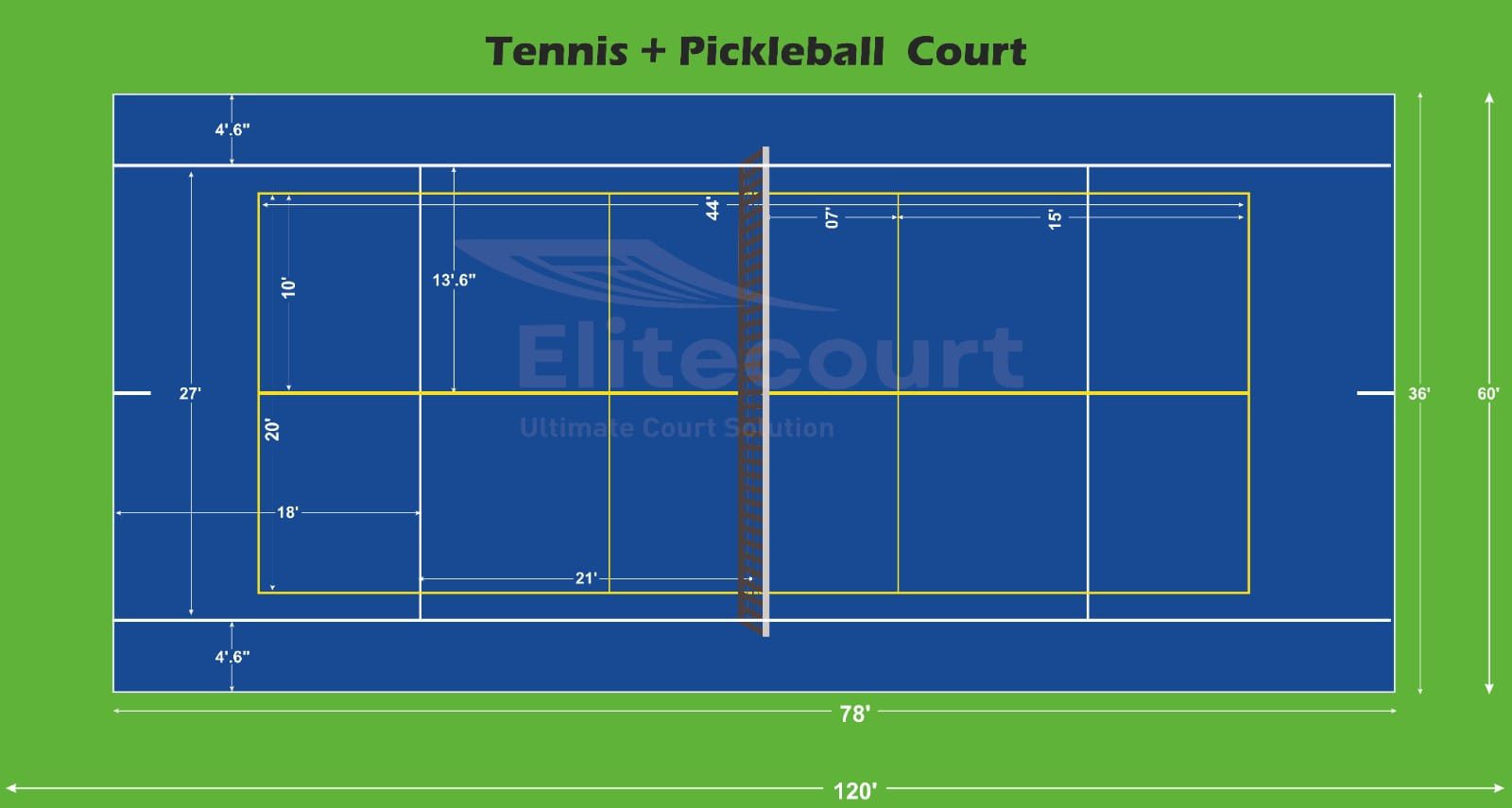
How Many Pickleball Courts Can Fit Inside a Tennis Court?
The number of pickleball courts you can fit onto a tennis court depends on the facility goals. Whether the intention is casual recreational play, dedicated pickleball zones, or maximum occupancy for tournaments, tennis courts offer multiple configuration options.
Is a Single Pickleball Layout Possible?
Yes, a single pickleball court can be placed centrally over a tennis court. This uses only a small section of the tennis surface and is ideal when the goal is simple recreational use or temporary conversion.
Benefits of this approach include:
- Minimal marking or adjustment required
- Easy transition back to tennis
- Reduced visual clutter
- Ideal for light or mixed-use play
A single-court conversion is often the best choice for private facilities, schools, and residential clubs.
Can You Mark Two Pickleball Courts on One Tennis Court?
Absolutely — and this is one of the most popular configurations. Two pickleball courts fit side-by-side within the width of a tennis court, providing efficient usage without overcrowding.
Advantages include:
- Perfect balance between space and play capacity
- Comfortable spacing between courts
- Minimal interference between players
- Effective for small groups or coaching sessions
This two-court layout maximizes the tennis court’s width without compromising player safety or comfort.
Is Four-Court Conversion Practical?
Yes — when used correctly. Four pickleball courts can be arranged inside a tennis court for high-capacity play, especially at community centers or clubs prioritizing pickleball demand.
This setup works best when:
- Courts have adequate fencing
- The surface is freshly coated with high-visibility pickleball lines
- The facility aims to host group sessions or shared community play
Elitecourt’s acrylic flooring systems support clear multi-color layouts, which is essential for courts with this level of line density.
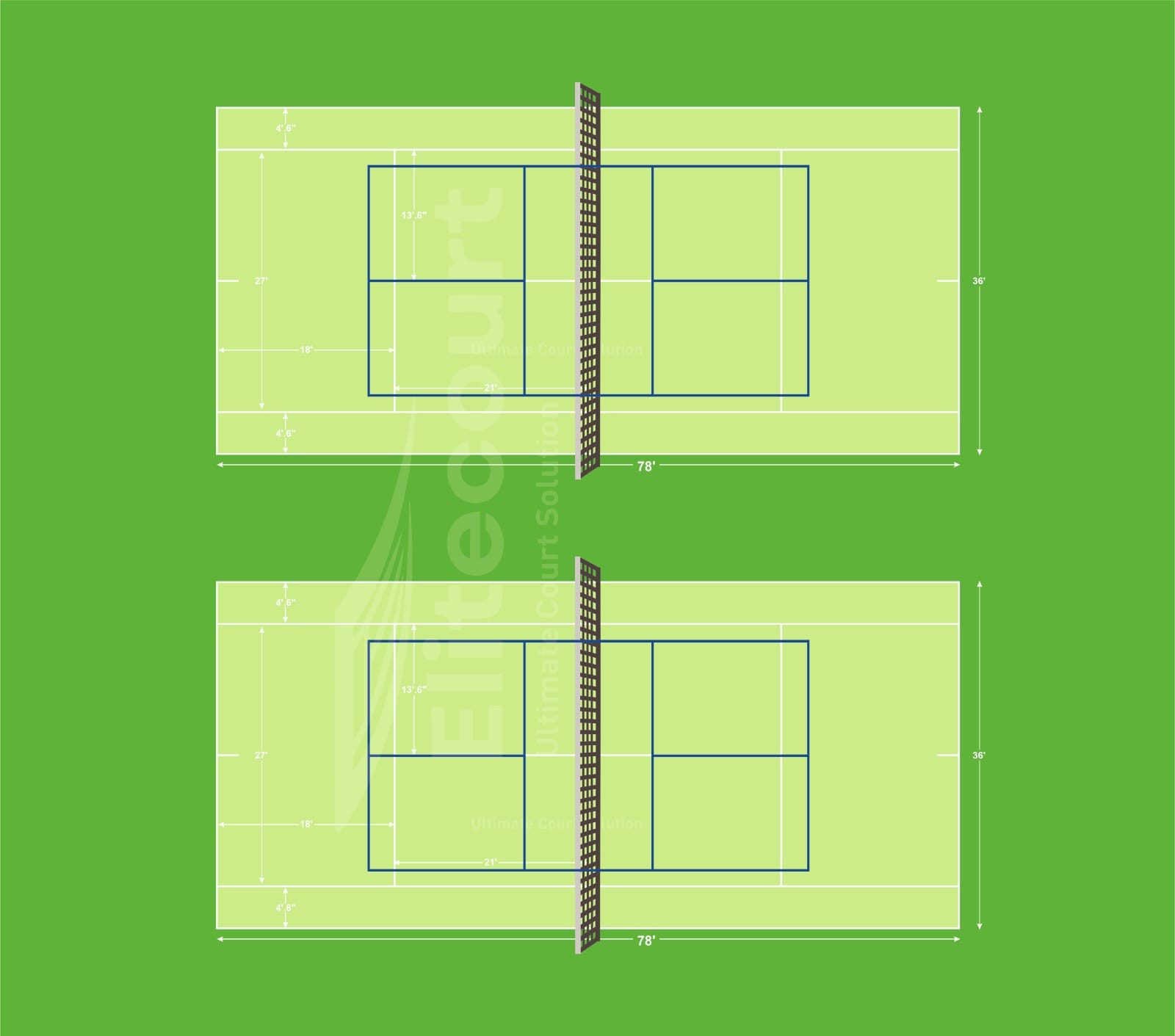
What Surface Works Best for Pickleball on a Tennis Court?
Pickleball requires consistent bounce, controlled speed, and dependable traction. This is why the synthetic acrylic system used in tennis courts is also the industry standard for pickleball courts.
Why Acrylic Flooring Is the Preferred Choice
Acrylic flooring provides:
- Predictable ball bounce
- Non-slip traction for controlled footwork
- UV-resistant color stability
- Durable, weather-tolerant performance
- Comfortable playability for all age groups
Pickleball is played with a perforated polymer ball, which needs a stable, slightly textured surface to achieve consistent bounce and predictable gameplay. Acrylic systems deliver exactly that.
How Elitecourt’s Synthetic Acrylic Enhances Dual-Sport Performance
Elitecourt’s manufacturing process ensures:
- Uniform surface texture for accurate bounce control
- High-grade pigmentation for clear and lasting lines
- Specialized acrylic formulations for slip resistance
- Cushioning options for added comfort
Because Elitecourt focuses exclusively on manufacturing surface materials—and not installation—we ensure the highest product purity and quality control for professional-level use.
Transform Your Sports Facility Today!
Contact us for high-quality synthetic sports flooring material and elevate your space!
How Do You Mark a Tennis Court for Pickleball?
Marking a tennis court for pickleball is one of the most important steps in making both sports function smoothly on the same surface. Because tennis courts are significantly larger, the key lies in overlaying a smaller pickleball boundary without creating visual confusion or affecting the original lines. The quality of markings, their visibility, and their durability all influence the player experience, especially in shared-use environments. Elitecourt’s acrylic coatings are designed to ensure crisp, long-lasting color borders that maintain clarity even under heavy sun exposure and ongoing play.
Temporary Marking Options
Temporary markings are ideal for multi-purpose facilities that prefer not to commit to permanent lines. A few popular temporary solutions include:
- Acrylic-compatible removable tapes
- Non-residue sports floor marking tapes
- Chalk-based temporary paint
Temporary lines offer flexibility, which is perfect for clubs, school courts, or shared recreational spaces. They allow the tennis surface to remain visually clean when pickleball is not in use. Additionally, removable tape systems are easy to install and do not damage acrylic surfaces when peeled correctly. However, they must be replaced periodically, especially after exposure to humidity, rainfall, or intense play.
Permanent Marking Solutions
Permanent markings are the most reliable option when both sports are used frequently. These markings are part of the acrylic coating system and provide exceptional clarity, durability, and weather resistance. Clear two-color strategies—such as light blue for tennis and orange or yellow for pickleball—help players immediately distinguish boundaries, reducing visual overlap.
Elitecourt’s acrylic materials allow installers to apply high-contrast, UV-stable lines. This ensures the markings remain sharp over time and do not fade or blur. Permanent lines also maintain uniform edge quality, which is essential for competitive or high-level recreational play.
How Do You Adjust the Net Height Correctly?
Pickleball requires a lower net than tennis, which means the net must be adjusted for accurate play. There are three common methods:
- Using a Portable Pickleball Net
This lightweight option sits directly on the court and maintains the correct height—36 inches at the sidelines and 34 inches at the center. - Adjusting the Existing Tennis Net
Tennis nets can be temporarily lowered, though they will still be slightly wider than a standard pickleball net. This option works well for casual play. - Using a Drop-in Center Strap Adapter
A simple strap can bring the center of a tennis net down to pickleball height without altering the posts.
These adjustments allow for full pickleball functionality without permanently changing tennis court infrastructure.
Does Pickleball Play Differently on a Tennis Court Surface?
Although the core flooring system is similar, the playing experience does differ slightly when pickleball is played on a tennis court. The variations are subtle but meaningful, especially for players sensitive to ball bounce, footwork, or pace.
What Happens to Ball Bounce?
On an acrylic tennis court, the bounce remains consistent and predictable—qualities essential for both sports. Pickleballs are lightweight and perforated, so:
- The bounce is firmer and more energetic than on softer modular surfaces
- Ball control during volleys improves due to cleaner rebound
- The pace of rallies increases on smooth, well-coated acrylic
This creates a faster game, which many players prefer because it enhances competitive intensity.
How Does Traction Influence Footwork?
Acrylic surfaces provide moderate, controlled traction, allowing players to:
- Move quickly without slipping
- Brace effectively for dinks, volleys, and serves
- Change direction smoothly during extended rallies
Since pickleball requires compact footwork compared to tennis, traction becomes even more important. Elitecourt’s acrylic materials support stable play across diverse weather conditions while maintaining the correct friction coefficient recommended for sports surfacing.
Does the Playing Speed Change?
Yes — playing pickleball on a tennis surface typically results in a slightly faster pace. This is due to:
- Low-friction surface texture
- Consistent bounce
- Wider boundaries that allow players to accelerate
While some players appreciate the increased speed, those who prefer slower games can opt for cushioned acrylic systems that reduce ball speed slightly by softening the impact surface.
What Challenges Arise When Using a Tennis Court for Pickleball?
Although dual-sport usage is efficient and common, it brings a few technical challenges that require proper surface materials and responsible usage.
Does It Create Extra Surface Wear?
Pickleball paddles and balls produce less friction than tennis racquets and balls. Therefore, the game does not create unusual or harmful wear on acrylic surfaces. However, increased foot traffic may lead to broader movement patterns across the court, which can increase overall wear if the surface is not properly maintained.
Can Lines Become Confusing?
Yes — line confusion can occur if markings are not placed thoughtfully. This is why Elitecourt’s acrylic systems support:
- Multi-color line clarity
- UV-stable contrasting pigments
- High-edge-definition coatings
These distinctions eliminate visual overlap and help both tennis and pickleball players follow boundaries confidently.
What About Shared Court Scheduling?
As the popularity of pickleball rises, tennis players sometimes feel their court time is reduced. The solution lies in clear, scheduled blocks for each sport and thoughtful planning to allow maximum usage without conflict.
Transform Your Sports Facility Today!
Contact us for high-quality synthetic sports flooring material and elevate your space!
Can Pickleball and Tennis Coexist on One Court Smoothly?
The growing popularity of pickleball has led many facilities to combine it with tennis on existing courts. While it may seem challenging at first glance, dual-sport usage works remarkably well when planned correctly. The key is understanding how each sport interacts with the court surface, the lines, and the overall playing environment. With thoughtful design, high-quality acrylic coatings, and smart scheduling, both sports can coexist seamlessly without diminishing the enjoyment or performance of either.
When Shared Use Works Best
Shared use is ideal when:
- The facility needs to accommodate rising pickleball demand
- Tennis players are open to scheduled blocks
- The court has crisp, well-contrasted line markings
- The acrylic coating quality supports multi-purpose visibility
By pairing the right colors for each sport, the boundaries remain easy to follow. Pickleball lines are typically thinner and painted in a contrasting shade from tennis lines, allowing players to effortlessly focus on their game. Acrylic surfacing—especially when manufactured with stability and precision—plays a huge role in ensuring lines remain sharp across seasons.
Another benefit of shared use is efficient space management. Converting a single tennis court into two or even four pickleball courts dramatically increases participation capacity without the expense or need for additional land. Many community centers and clubs achieve this by dividing peak hours between the two sports, keeping everyone satisfied while maximizing the facility’s value.
When You Should Avoid Multi-Use
Although shared courts are generally successful, there are moments when it may not be ideal:
- When the tennis court’s surface is too worn for high-visibility multi-color lines
- When players in both sports compete for peak hours simultaneously
- When the fencing structure cannot support multiple pickleball courts safely
- When the court slope or layout does not meet recommended play standards
In these cases, it may be better to dedicate certain courts to one sport or the other. However, with Elitecourt’s advanced acrylic materials, most facilities find it easy to create a multi-use surface that satisfies everyone and stands up to repeated play.
Does Pickleball Damage a Tennis Court?
This is one of the most frequently asked questions among facility managers, sports directors, and tennis associations. The short and clear answer is no — pickleball does not damage a tennis court when the surface is built with high-quality acrylic materials like those manufactured by Elitecourt.
Pickleball equipment is lightweight compared to tennis racquets and balls, producing significantly less friction and impact. The paddle contact is soft, and the ball itself is hollow and perforated. This means the surface experiences gentler force compared to tennis play.
What Happens to Acrylic Layers?
Elitecourt’s acrylic systems are engineered to withstand:
- Repeated foot traffic
- Impact from sports equipment
- UV exposure
- Temperature changes
Because pickleball movements involve shorter steps and less sliding, there is actually less abrasive contact with the surface compared to tennis. As long as the acrylic layer is well-applied and maintained, the court will retain its texture, color, and stability.
The only consideration is the increased number of players on the surface when multiple pickleball courts are placed inside one tennis court. Higher foot volume may accelerate the need for routine maintenance — not because of the sport, but because of increased occupancy.
Do Nets or Posts Get Affected?
When portable nets are used, tennis net posts remain unaffected. Even when lowering a tennis net temporarily for casual pickleball games, there is no long-term impact on the posts or anchor points. Acrylic-coated lines also remain undamaged, as pickleball requires lighter foot pressure and smaller ball impacts.
Overall, pickleball is considered one of the gentlest sports on acrylic court surfaces.
What Should You Check Before Converting a Tennis Court to Pickleball?
Before marking pickleball lines on a tennis court or setting up temporary systems, it’s important to evaluate the court’s readiness. Converting without proper assessment can affect play quality, ball response, and safety.
Do You Need a Surface Inspection?
A professional inspection ensures the surface:
- Is level and free of water pooling
- Has no structural cracks affecting ball bounce
- Meets recommended slope standards for sports courts
- Maintains uniform texture across the entire playing area
These conditions help preserve the integrity of both tennis and pickleball play.
Should Cracks or Slopes Be Corrected First?
Cracks should be properly sealed before installing any pickleball-specific markings. Even small cracks can influence pickleball’s lighter ball bounce more noticeably than tennis balls. Similarly, inappropriate slopes may cause irregular ball behavior or water accumulation.
A tennis court typically has a controlled slope for drainage, but if it’s too steep or uneven, it may impact pickleball responsiveness.
Which Color Coatings Improve Visibility?
Color selection plays a major role in dual-sport clarity. Facilities often use:
- Blue or green for tennis boundaries
- Yellow or orange for pickleball lines
Elitecourt offers high-stability pigments that remain vibrant over time, even under intense outdoor conditions. High contrast ensures no confusion between lines, improving the playing experience for both sports.
Elitecourt Recommendations: What’s the Best Way to Build a Dual-Sport Surface?
Elitecourt specializes in manufacturing advanced acrylic systems that support precision, longevity, and professional sports performance. When designing a tennis-pickleball shared surface, certain technical refinements can elevate quality and consistency.
Should You Use Acrylic Cushion Systems?
Acrylic cushion systems add a layer of comfort beneath the top coat. This helps:
- Absorb impact for players
- Reduce joint stress
- Create slightly softer bounce characteristics
For pickleball, this results in more controlled rallies and better shock distribution, especially during competitive play.
How to Optimize Ball Response
Elitecourt’s acrylic layers are engineered to deliver:
- Uniform surface roughness
- Consistent friction
- Predictable ball rebound
These attributes ensure that both tennis balls and pickleballs behave reliably, providing a professional experience without compromise.
What Color Combinations Are Most Effective?
Using contrasting tones prevents line overlap. Popular combinations include:
- Blue main court with yellow pickleball lines
- Green main court with white tennis lines and bright orange pickleball lines
The objective is to ensure instant visual differentiation for players.
Transform Your Sports Facility Today!
Contact us for high-quality synthetic sports flooring material and elevate your space!
Is It Safe to Play Pickleball on a Tennis Court?
Safety is one of the most important considerations when adapting a tennis court for pickleball. Even though both sports use similar surfaces, they require different footwork patterns, ball speeds, and player movements. A well-prepared acrylic court ensures that players enjoy a secure environment with the right traction, stability, and impact absorption.
Impact Absorption Needs
Acrylic surfaces are engineered to deliver a balanced combination of firmness and mild cushioning. While pickleball players move in tighter spaces, the sport involves quick, sharp steps, controlled lunges, and sudden stops. Surface systems that provide appropriate impact absorption can help:
- Reduce joint pressure
- Enhance comfort during extended games
- Create a more forgiving playing experience
- Support safe lateral movement
Elitecourt’s acrylic formulations allow installers to integrate cushioned layers beneath the top surface, offering enhanced comfort without compromising bounce consistency.
Slip Resistance Requirements
Slip resistance is essential for both tennis and pickleball, but pickleball players tend to pivot and stop more frequently due to the smaller court dimensions. The surface must maintain a specific friction coefficient to balance grip and slide.
Elitecourt materials ensure:
- Predictable traction
- Consistent court texture
- Safe movement during rapid direction changes
Proper slip resistance minimizes the risk of sliding accidents, especially in humid or mildly wet conditions.
Environmental Variables to Consider
Outdoor courts must handle a wide range of environmental elements, including:
- Heat exposure
- UV radiation
- Dust and debris
- Rainwater drainage
Acrylic systems offer weather resilience, ensuring the court retains its texture and play characteristics across seasons. Adequate drainage is especially important for pickleball because the lightweight ball is more sensitive to moisture and surface puddling.
By choosing the right surface system and maintaining it well, players can confidently enjoy pickleball on a tennis court without compromising safety.
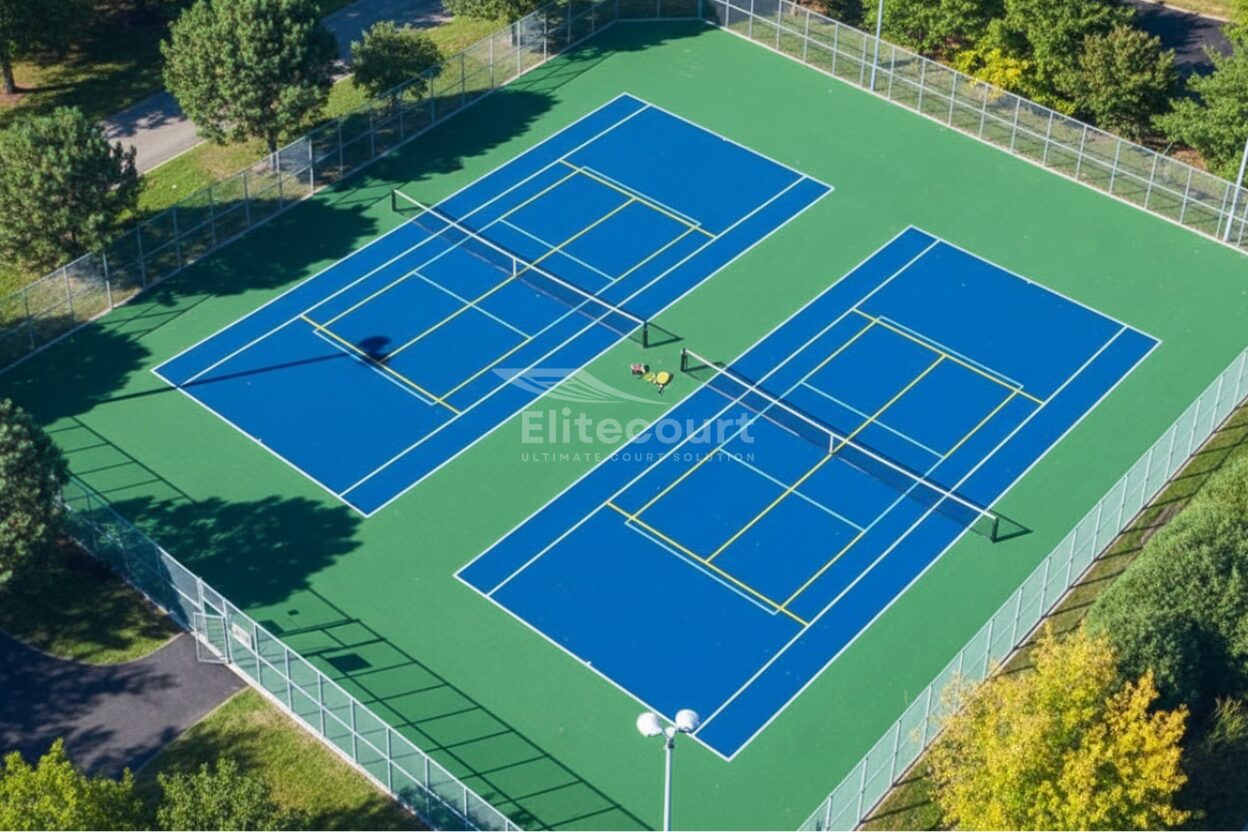
How Do You Maintain a Tennis Court Used for Pickleball?
Dual-sport courts experience different types of usage patterns, making maintenance an important part of preserving performance and longevity. While acrylic surfaces are durable and resistant to wear, regular care ensures that the court remains visually clear, structurally sound, and enjoyable for both sports.
Routine Care
Routine maintenance includes:
- Sweeping debris such as leaves, dust, and dirt
- Removing surface stains caused by organic matter
- Inspecting lines to ensure visibility remains strong
- Clearing drainage channels to prevent water pooling
Frequent cleaning keeps the surface friction and bounce consistent, which is especially important for pickleball’s lighter ball.
Daily Use Advice
For facilities with high foot traffic, simple daily habits can extend the court’s lifespan:
- Encourage players to use non-marking shoes
- Remove equipment carefully, avoiding surface dragging
- Avoid placing heavy objects on the court
- Ensure that portable nets are stored properly
These steps reduce friction-based wear and keep the surface looking fresh.
How to Protect the Surface from Weather
Weather-related maintenance includes:
- Inspecting for UV fading
- Cleaning dust accumulated during dry seasons
- Washing away dirt after heavy rains
- Ensuring the slope drains water efficiently
Elitecourt’s acrylic materials are designed to resist UV exposure and maintain color brilliance for long periods, but regular inspections prevent long-term wear from going unnoticed.
These maintenance standards help ensure that a tennis-to-pickleball dual court continues offering the best possible playing experience for both sports.
Conclusion
Playing pickleball on a tennis court is not only possible but also one of the most efficient ways for facilities to support both sports without costly reconstruction. Tennis courts offer ample space, strong acrylic surfaces, and reliable infrastructure that make the conversion straightforward and highly functional. Whether you choose temporary markings, permanent layouts, or multi-court configurations, the process works smoothly when supported by high-quality surfacing materials.
Elitecourt’s synthetic acrylic systems provide the clarity, durability, slip resistance, and professional performance required for both tennis and pickleball. By ensuring proper markings, safe traction, and consistent bounce, facilities can enjoy flexible dual-sport environments that meet the expectations of growing player communities. With thoughtful planning and the right materials, pickleball and tennis can coexist beautifully on the same court—supporting versatility, increased participation, and long-term value for your sports facility.
FAQS
Yes. Many facilities choose to permanently transform a tennis court into one or multiple pickleball courts. This involves applying permanent acrylic lines and adjusting net systems. While permanent conversion is common, shared-use layouts are equally popular for multi-sport environments.
Absolutely. Acrylic surfacing provides the consistent bounce, traction, and stability required for both tennis and pickleball. Elitecourt’s high-quality synthetic acrylic systems ensure clarity, durability, and long-term performance for dual-sport facilities.
Depending on goals and space allocation, one, two, or four pickleball courts can fit comfortably within a tennis court. Two-court configurations are the most common, while four-court setups are ideal for maximizing participation and group play.
Not if applied correctly. High-quality removable tapes or temporary paints offer clear markings without interfering with tennis lines. They can be removed without damaging the acrylic surface and are ideal for flexible usage schedules.
High-contrast combinations work best. Common approaches include blue or green tennis boundaries with bright yellow or orange pickleball lines. Elitecourt’s UV-stable pigments guarantee visibility and long-term color retention.


